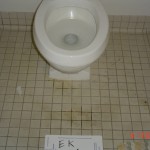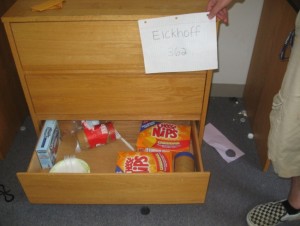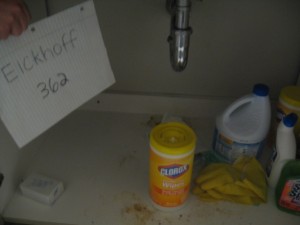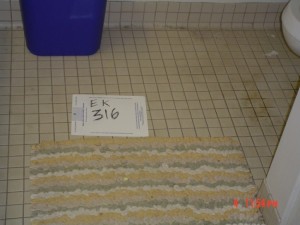CA and HA closing and transition responsibilities:
CAs are responsible for doing an RCR in all student rooms, for three purposes:
identify any dirty rooms
messy, dirty, or disgusting spaces
Dirty is a subjective term, so employ your critical thinking skills and be consistent with your definitions. Ask yourself – how dirty is the room? Messy? Dirty? Disgusting? How long has it been without cleaning?
These pictures represent a room that hasn’t been cleaned in about a month. They exhibit some dust on the floor or counters, trash not taken out, a few small items left behind (cleaning supplies, food, bottles, a little garbage), or may look like the residents moved out hastily.
These pictures represent the lowest acceptable standard we tolerate. If a room is as messy as, or less messy than, the pictures above, the room does not need to be identified. If the room EXCEEDS this level of mess, identify it on the dirty room list.
Messy rooms should be photographed, with file names corresponding to the room number.
identify any large items left behind
large items left behind
If residents leave large items behind that a building attendant won’t be able to carry out by his/herself, these rooms should be noted on the large items left behind list.
Examples may include:
- Cinder blocks or bricks
- Personal furniture like a large bookshelf or futon
- Area rugs (larger than 3×5), either rolled up or still on the floor
- A significant amount of clothes or trash (3 or more bags)
Any large items left behind in common areas should also be noted (i.e. TV stand left behind in a house lounge, futon pushed into the hallway).
These items should be photographed, with file names corresponding to the room number.
identify items in poor condition and generate work orders
items poor condition and work orders
Careful attention should be given to the overall condition of the room’s main components:
- walls
- floor/ceiling
- bed frame and mattress
- desk and chair
- wardrobe/closet
- dresser
- doors/windows
- sink/bath
- common spaces
Inspect each of the room’s items and consider how this room/item looks in relation to the average room in each building, noting any items that are in poor condition on the RCR form.
RCR examples include:
- items in the room that are broken and need repair (light switch not working, towel rack hanging from wall, toilet not flushing properly, dresser drawer detached);
- stains, marks, or dirty items (red stains on carpet or floor, walls with holes or tape or funtack, paint chips, etc.)
- furniture issues (dresser drawer removed, bed very wobbly, hutch split or cracked, shelves detached, etc.)
- intentional vandalism or excessive wear and tear (things written on walls or furniture, holes in walls (larger than a quarter), walls painted, window cracked or broken, blinds significantly damaged)
- Ethernet/cable jack broken or detached from wall
DO NOT include things on the RCR that are standard or common for the building. I.e. in buildings with older dressers (like NR), you do not need to list that the dresser drawers stick. In buildings with old carpeting (like ABE), you do not need to list that the carpet has small stains or discoloration, unless it looks significant and is worse than the standard.
If the item needs to be repaired or something is identified as broken, please also list the room number and item description on the work order list.
Any items that are listed in poor condition should be photographed, with file names corresponding to the room number.
After completing your initial dirty room check and RCRs, type up the information and submit them to your SMRO for review.
Check with your SMROs on the approximate amount of time you should spend on a room’s RCR.
Any items that are in poor condition, any dirty rooms, or any large items left behind need a picture.




